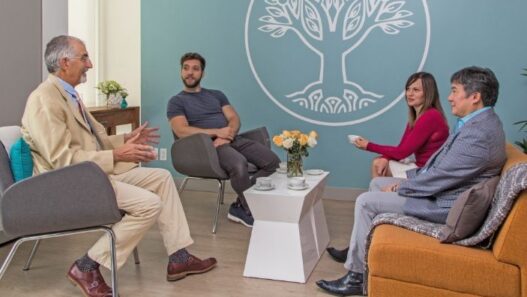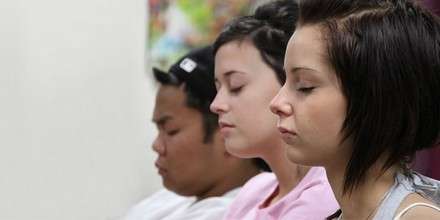To kick off the release of her brand-new album Witness, Katy Perry did something curious: she live-streamed her life for 96 hours on YouTube.
During the event named Witness worldwide, 49 million fans from 190 different countries tuned in to see Perry eat, sleep, meditate, play with her dog, hang around with friends, undergo a therapy session, and talk about things that matter to her.
Perry dedicated one segment of the live stream to exploring Post-Traumatic Stress Disorder (PTSD) in veterans and how it can be relieved with the help of Transcendental Meditation (TM).
Perry has been a vocal advocate of TM, crediting the meditation practice by changing her life and powering her creative process. She has also stepped up frequently either by performing or auctioning off meet-and-greet opportunities to raise funds for the David Lynch Foundation, an organization that enables underserved populations to learn the effective stress-busting technique.
The segment on PTSD and Transcendental Meditation on Witness worldwide started off with a video featuring Paul Downs, a Marine veteran who served in the military for 11 years.
In the clip, Downs told his story:
“When I hung up the uniform, I fell apart. Traumas that I brought into the marine corp caught up. That led to a pretty detailed plan for suicide.”
Luckily, Downs turned to the Warrior PATHH (Progressive and Alternative Training for Healing Heroes) program at Boulder Crest Retreat center, a unique intervention designed to transform times of deep struggle into profound strength and growth.
“During the Warrior PATHH, they introduced me to a variety of different modalities and one of the most pivotal was Transcendental Meditation.
Focusing on the 20 minutes twice a day of Transcendental Meditation, I now have the connection to myself I did not have,” Downs explained.
Downs also touched upon why TM has a unique advantage compared to some of the other methods, which also help to turn Post-Traumatic Stress into Post Traumatic Growth.
“One thing we did at Bolder Crest was archery, but I cannot do that in an airplane. I cannot take a horse on an airplane or into a traffic jam. But I can use my TM, I can meditate, I can use my mantra in a traffic jam. That’s why TM is so pivotal. I can take it anywhere.”
Following the video, Perry’s fans all over the globe could see the artist speak with Paul Downs and Dusty Baxley who are both veterans and Warrior PATHH instructors.
In their discussion, Downs and Baxley underscored the importance of teaching veterans how to interact with the world in a way that better suits civilian life.
“Say I am having a conversation with someone about a problem and it elevates. Then my natural tendency, because my body is trained that way, is to drop that adrenalin, so I meet force with force.” Baxley explained how military training can cause difficulties in life outside the combat zone.
“We can’t witness. We don’t have that space. We can’t witness the story in someone else because we cannot even see our own,” Downs added.
“We can’t respond, so what we do is react to it. Once we react, we realize we’ve overreacted. Then we judge ourselves, then we self-medicate, and then we isolate. There’s an endless cycle because the heart’s been turned off.
It’s the 18 inches from here to hear that we have to learn to re-connect,” Baxley said, pointing to the distance between the heart and the head, fascinating Perry with the imagery.
“From eye to eye, we are great, but that’s reacting to life,” Baxley explained further.
“That’s surviving. For so long, there are so many people stuck in survival because it’s ancient. That’s what we’ve done,” Downs added.
“You learn to react to everything, Katy, and what we get to do is to teach this beautiful program called Warrior PATHH at Boulder Crest retreat, in which Transcendental Meditation is our pillar meditation practice.
It’s a combat stress reduction program for what we call Post-Traumatic Growth.” Baxley explained the concept of Warrior PATHH to Perry.
Perry related to the idea by pointing out that life naturally comprises difficulties. “You cannot have the up without the down! But also, I like to remind myself when I’m having the down that the up is on its way.”
“Post-Traumatic Growth focuses on the idea that the up does not have to be just bouncing back to where you were. The up can be better. You can get stronger from this struggle,” Downs explained.
“Stronger from the struggle, for sure, that’s my life,” Perry related to the idea.
“What we learn to do finally is to connect our thoughts, our feelings, and our reactions again so that we become congruent. So, when my beautiful wife is talking to me, I’m not up in my head. I’m actually listening to her with my heart, and I can empathize and be compassionate and be present in the moment.” Baxley summed it up.
While Baxley and Downs approached the topic from their experiences as veterans battling with PTSD, people from all walks of life could relate to their discussion of reacting to rather than relating to other people in their everyday life.
As their story shows, everyone, no matter how traumatic our experiences or how ingrained our patterns are, can make a switch from merely surviving to truly live.


















